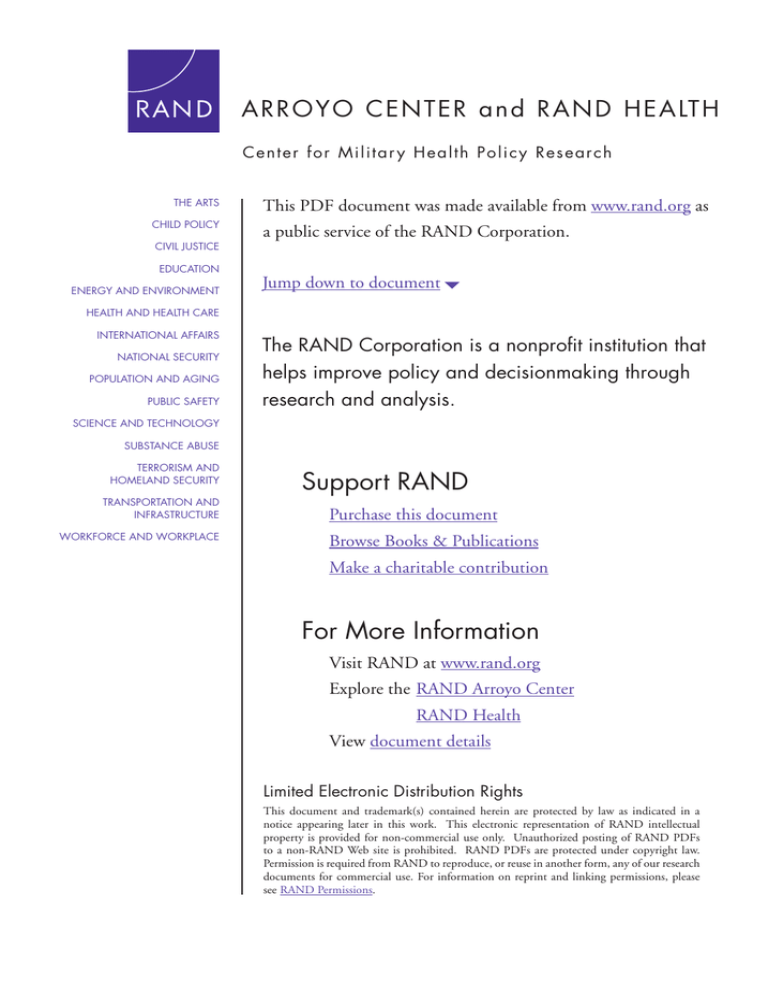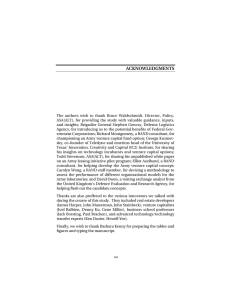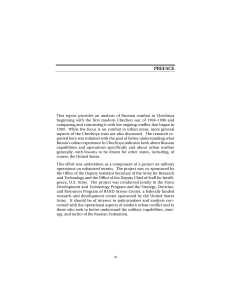6 ARROYO CENTER
advertisement

A R R O Y O C E N T E R a n d R A N D H E A LT H C e n t e r f o r M i l i t a r y Health Policy Research THE ARTS CHILD POLICY CIVIL JUSTICE EDUCATION ENERGY AND ENVIRONMENT This PDF document was made available from www.rand.org as a public service of the RAND Corporation. Jump down to document6 HEALTH AND HEALTH CARE INTERNATIONAL AFFAIRS NATIONAL SECURITY POPULATION AND AGING PUBLIC SAFETY The RAND Corporation is a nonprofit institution that helps improve policy and decisionmaking through research and analysis. SCIENCE AND TECHNOLOGY SUBSTANCE ABUSE TERRORISM AND HOMELAND SECURITY TRANSPORTATION AND INFRASTRUCTURE WORKFORCE AND WORKPLACE Support RAND Purchase this document Browse Books & Publications Make a charitable contribution For More Information Visit RAND at www.rand.org Explore the RAND Arroyo Center RAND Health View document details Limited Electronic Distribution Rights This document and trademark(s) contained herein are protected by law as indicated in a notice appearing later in this work. This electronic representation of RAND intellectual property is provided for non-commercial use only. Unauthorized posting of RAND PDFs to a non-RAND Web site is prohibited. RAND PDFs are protected under copyright law. Permission is required from RAND to reproduce, or reuse in another form, any of our research documents for commercial use. For information on reprint and linking permissions, please see RAND Permissions. This product is part of the RAND Corporation monograph series. RAND monographs present major research findings that address the challenges facing the public and private sectors. All RAND monographs undergo rigorous peer review to ensure high standards for research quality and objectivity. New Equipping Strategies for Combat Support Hospitals Matthew W. Lewis, Aimee Bower, Mishaw T. Cuyler, Rick Eden, Ronald E. Harper, Kristy Gonzalez Morganti, Adam C. Resnick, Elizabeth D. Steiner, Rupa S. Valdez Prepared for the United States Army Approved for public release, distribution unlimited AR R OYO C ENTER a nd RA ND HEA LTH C ent er for Milita r y Hea lth Policy Resea r ch The research described in this report was sponsored by the United States Army under Contract No. W74V8H-06-C-0001. Library of Congress Cataloging-in-Publication Data New equipping strategies for combat support hospitals / Matthew W. Lewis ... [et al.]. p. cm. Includes bibliographical references. ISBN 978-0-8330-4996-4 (pbk. : alk. paper) 1. Military hospitals—United States—Equipment and supplies. 2. Military hospitals— United States—Planning. 3. Military hospitals—United States—Management. 4. United States. Army—Medical supplies. I. Lewis, Matthew W. UH473.N38 2010 355.3'45—dc22 2010019796 The RAND Corporation is a nonprofit research organization providing objective analysis and effective solutions that address the challenges facing the public and private sectors around the world. R AND’s publications do not necessarily reflect the opinions of its research clients and sponsors. R® is a registered trademark. © Copyright 2010 RAND Corporation Permission is given to duplicate this document for personal use only, as long as it is unaltered and complete. Copies may not be duplicated for commercial purposes. Unauthorized posting of RAND documents to a non-RAND Web site is prohibited. RAND documents are protected under copyright law. For information on reprint and linking permissions, please visit the R AND permissions page (http://www.rand.org/ publications/permissions.html). Published 2010 by the RAND Corporation 1776 Main Street, P.O. Box 2138, Santa Monica, CA 90407-2138 1200 South Hayes Street, Arlington, VA 22202-5050 4570 Fifth Avenue, Suite 600, Pittsburgh, PA 15213-2665 RAND URL: http://www.rand.org To order RAND documents or to obtain additional information, contact Distribution Services: Telephone: (310) 451-7002; Fax: (310) 451-6915; Email: order@rand.org Summary Combat Support Hospitals The U.S. Army uses Combat Support Hospitals (CSHs)—mobile, deployable hospitals housed in tents and expandable containers—to provide surgical and trauma care close to combat action. A CSH is a 248-bed hospital staffed by approximately 500 personnel. Modular in design, it can also operate as two geographically separated hospitals (“split-based operations”), one with 164 beds and the other with 84 beds. CSHs provide the highest level of in-theater medical care available to American military personnel serving in active, deployed operations, including stabilization and surgical capabilities comparable to those in the trauma centers of major hospitals in the United States. Currently the Army has 29 CSHs, soon to be reduced to 26: 10 in the active component (8 in the continental United States and 2 forward stationed in South Korea and Germany) and 16 in the U.S. Army Reserve. Equipping and Maintenance Challenges A CSH’s ability to deliver high-quality medical care depends in large part on its possessing well-maintained, state-of-the-art medical equipment. However, a CSH’s need for medical equipment is not stable but rather varies widely depending on whether it is preparing to deploy, deployed, available to be deployed, or returning from a deployment. • CSHs typically only operate as hospitals when they are deployed, and deployments are infrequent: for an active component CSH, no more often than one year out of three; for a reserve CSH, no more often than one year out of five. • Even if deployed, a CSH often does not deploy with its own medical equipment. Instead, its personnel often fall in on equipment downloaded from Army Prepositioned Stocks (APS) or Theater Provided Equipment (TPE). • When not deployed, the CSH’s primary need for equipment is to support training activities that rarely require a full-scale 248-bed hospital, so a large portion of its equipment is stored at the Sierra Army Depot (SIAD) and not accessed. xi xii New Equipping Strategies for Combat Support Hospitals In addition, like all hospitals, CSHs must keep their medical equipment state of the art. Since much CSH equipment is not in continual use, items can become outdated while receiving limited or even zero use. Thus, questions arise regarding when equipment should be upgraded and whether it is worthwhile for the Army to keep equipment used for training or stored at SIAD upgraded to the same degree as the equipment being used by deployed CSHs. Research Objective and Approach The Surgeon General of the U.S. Army sponsored the research reported here to develop and evaluate alternative strategies for equipping the Army’s CSHs that would meet their equipment needs in all phases of the deployment and redeployment cycle (the ARFORGEN [Army Force Generation] cycle). We employed a number of methods to execute the research. To gain an understanding of the perspectives of AMEDD (Army Medical Department) personnel on the current state of equipping and maintenance, we conducted focus groups, surveys, and interviews. We attended AMEDD conferences and visited key sites and organizations to conduct interviews. To understand costs and obsolescence risk, we analyzed data on CSH medical equipment maintenance, procurement, requirements, useful life, and obsolescence rates. To understand the prospective value and feasibility of alternative procurement strategies, we reviewed commercial and academic literature on leasing and conducted interviews with medical equipment procurement experts from hospitals, equipment manufacturers, and consulting organizations. To understand how alternative equipping strategies would perform over time, we used spreadsheet modeling and discrete event simulation. Findings Our analyses showed that the current CSH equipping and maintenance strategy has resulted in the Army owning more CSH medical equipment than it appears to need to support units throughout the ARFORGEN cycle, more than it seems to have the maintenance resources to keep in good condition, and more than it has had the budgetary resources to keep technologically current. CSH medical equipment resides in four large pools: • Home station equipment sets. These consist of the portion of a CSH’s 248-bed hospital it retains at home station, with the remainder being stored at SIAD. • Centralized assets. These are of two types, both stored at SIAD. First, there are almost two dozen 164-bed hospital modules, which are owned (i.e., on the property books) by CSHs and represent the portion or “balance” of their medi- Summary xiii cal equipment that units are storing while retaining the 84-bed modules at home station. Second, there are also four full 248-bed hospital equipment sets in the U.S. Army Medical Materiel Agency’s (USAMMA’s) Medical Materiel Readiness Program (MMRP), which are ready for immediate deployment with any CSH that might require them. • Training site equipment. The Army has three Regional Training Sites-Medical (RTS-Med) with full 248-bed CSH equipment sets plus a training facility with a partial CSH equipment set at Fort Polk (associated with the Joint Readiness Training Center) that can be used by CSHs to conduct training activities. • Army Prepositioned Stocks. The Army has six 248-bed hospitals and one 44-bed Early Entry Hospital Element (EEHE) module in APS. The current equipping and maintenance strategy has left the equipment in some of these four pools in better condition than others, in terms of both maintenance and technological currency. Currently, most CSH units do not own and train on the most up-to-date equipment except when they are deployed to Afghanistan and Iraq, where they fall in on modernized-generation equipment sets established in those theaters. The sets in APS, consisting of six full CSH sets and one 44-bed EEHE, are also technologically current, as are the two full CSH sets in the MMRP. By contrast, other CSH sets—including those at home station, those at the RTS-Med, and those stored at SIAD—have not been modernized in at least five years. Moreover, none of the equipment stored at SIAD is utilized either for training or missions—or at least has not been in a very long time. Recommendations Because the CSH equipment in APS and MMRP is technologically current and in good condition, we focused our efforts to develop an equipping and maintenance strategy to improve the situation in the other pools of equipment. For home station equipment sets, we recommend that the Army move to new designs that are better aligned with training needs, with different designs for active and reserve component CSHs. • If the Army decides that active component CSHs should have the capability to train for split-based operations at home station, it should adopt a design termed the Split-Based Operations (SBO) set. The SBO set would provide similar equipment and medical capability in both the Alpha and Bravo medical companies, providing two 32-bed hospitals, each with 12 ICU (intensive care unit) beds and 20 ICW (intermediate care ward) beds. Though the SBO design has fewer total beds than the current design, its adoption would double the surgical and trauma capability at home station. xiv New Equipping Strategies for Combat Support Hospitals • If active component CSHs can train for split-based operations elsewhere than at home station, such as at an RTS-Med, then they should adopt a set termed the Enhanced Capability, Single Base (ECSB). The ECSB design would provide a CSH with a single 32-bed hospital at home station on which it could train and execute all hospital functions (except for dental). • We recommend that reserve component CSHs adopt a very lean equipment set at home station, termed the Training Equipment Only (TEO) set. The TEO design would not provide a CSH with a full hospital or any real capacity to provide medical care locally; rather, it would provide a very limited set of equipment sufficient to allow the CSH personnel to train to conduct certain core hospital functions. We recommend that the Army regularly upgrade these sets during the Reset phase of the ARFORGEN cycle (i.e., every three years for active CSHs and every five years for reserve CSHs). For training sites, we recommend that the Army improve the currency of the equipment sets. We also recommend that it improve the flexibility of the sites to tailor the equipment configurations for training exercises to the needs of specific CSHs. Flexibility might be enhanced by leasing some medical equipment. For example, some of the medical equipment stored in APS or MMRP, which might not be used at all before being superseded in the Army’s inventory by newer models, might be considered for lease. For centralized assets at SIAD (other than MMRP), we recommend that the Army permit CSHs to share these assets rather than have a one-to-one correspondence between home station equipment sets and these partial “balance” sets at SIAD. Balance sets provide CSHs with the option of deploying with their home station equipment. To implement this aspect of the recommendation, the Army would need to address how CSHs would report their readiness when some of their MTOE (Modified Table of Equipment) is represented by shared equipment residing in a centralized asset pool. In conjunction, the Army should then reduce the number of balance sets, improving the condition and currency of the remaining sets, and change what equipment is in each set in accordance with the associated recommended changes in home station sets. Overall, we recommend an equipping and maintenance strategy that would result in fewer, but regularly modernized, full hospital sets systemwide, resulting in less total medical equipment: the total equipment replacement cost at today’s prices would decrease from approximately $1 billion to about $740 million, more than a onequarter reduction (see Figure S.1). A reduced inventory of medical equipment would reduce maintenance and upgrade costs, making it easier for the Army to ensure that CSH equipment is well maintained and state of the art. Nevertheless, the overarching intent of the recommended strategy is to improve training and deployed capabilities, not reduce costs. Summary xv Figure S.1 The Recommended Equipping and Maintenance Strategy Would Result in a Leaner Total Inventory of CSH Medical Equipment That Is Less Expensive to Maintain and Keep Current Replacement costs (millions) 1,200 27% reduction in total replacement costs 1,000 800 $421 Reduces and upgrades centrally managed equipment $164 $119 Increases AC training capability at home station $181 $191 Decreases USAR maintenance burden $117 $91 Need to upgrade sets $91 $184 No changes $184 600 400 200 Central AC home station USAR home station RTS-Med APS 0 Current Recommended Strategies SOURCE: USAMMA POM data, current replacement prices. RAND MG887-S.1 Implementing the New Equipping and Maintenance Strategy Because the recommended equipping and maintenance strategy would represent a radical departure from the current strategy in many respects, it needs to be vetted with stakeholders in the operations, maintenance, clinical, and training communities, and they should be included in efforts to refine and test the strategy. Thus, it would be prudent for the Army to begin moving toward the new strategy by fielding the new home station equipment designs at a few active and reserve CSHs, and then evaluating their performance in terms of the mission, maintenance, training, and manning effects of the designs. In conjunction, the Army should begin to reduce the number of balances in the Hospital Optimization and Standardization Program (HOSP) and Reserve Component Hospital Decrement (RCHD) programs at SIAD. The Army should survey CSH commanders to gain a detailed and updated understanding of what training products and services they would like to be able to obtain from the RTS-Med. Under the new strategy, the reserve CSHs may have a need to expand their reliance on RTS-Med and MTTs (Mobile Training Teams). The Army should address the desire of CSH commanders, expressed in focus groups, to have the medical equipment in the training base upgraded to current generation, and it should xvi New Equipping Strategies for Combat Support Hospitals anticipate a call for increased flexibility to tailor the training sites to mirror the equipment and facilities that deploying CSHs will encounter in deployed operations. To improve its flexibility to configure training sites, the Army should explore leasing as a means of permitting the RTS-Med to acquire equipment temporarily for training when the item is not part of the MTOE but is being used by CSHs in theater. The Army should further investigate leasing high-cost medical equipment with a short technological lifespan for centralized training and in pools that have a lower chance of deployment. The recommended equipping and maintenance strategy would substantially reduce the cost of equipping and maintaining the Army’s CSHs, while providing them with equipment that is newer and in better condition on average than what they have now. Additionally, further exploring into how RTS-Med, MTTs, and leasing could be leveraged could offer further opportunities.




